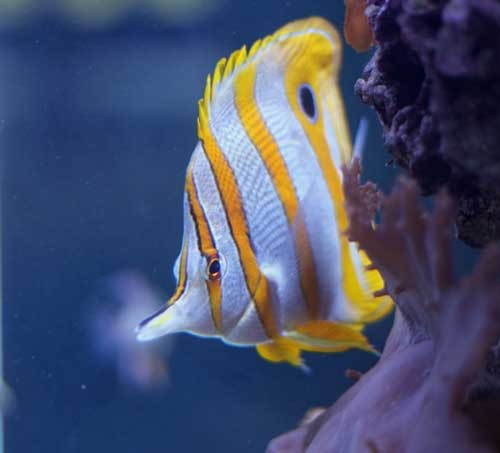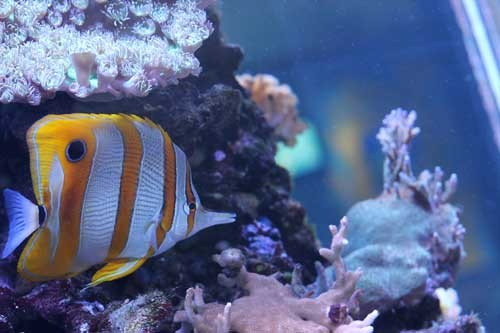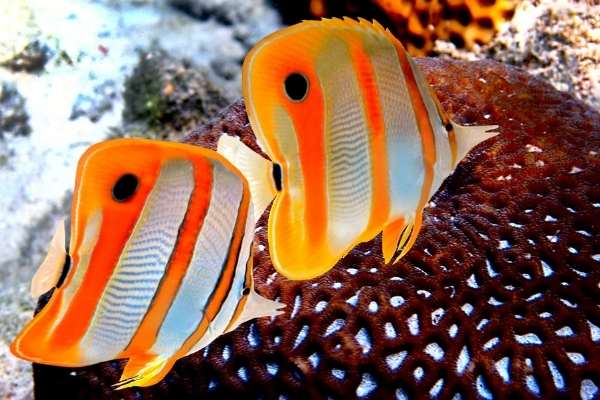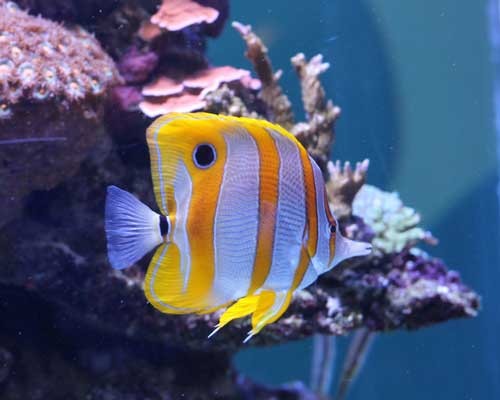[ad_1]
The Copperband butterflyfish is a beautiful and iconic saltwater aquarium fish species:
- The long nose, honed by evolution for picking meals from tiny crevices in the live rock
- The alternating black-lined goldfish yellow copper-colored bands and white coloration pattern.
- The false eyespot on the rear part of the dorsal fin and the relatively tall, slender build of the fish give it a graceful, pleasing appearance.
If you see one at a fish store, they are almost irresistible, but let’s dive a little deeper into what it takes to successfully care for this amazing saltwater fish.
Quick facts
- Scientific name: Chelmon rostratus
- Common names: Copperband butterflyfish
- Care level: Expert-only
- Aggression level: peaceful, not aggressive
- Reef safe: Not really
- Diet: Meaty foods (carnivore)
- Size: Medium-large, grows to 8-inches
- Minimum tank size: 100 gallons +
Native Habitat and Behavior
The copperband butterfly is a saltwater fish native to the coral reefs or rocky shores in the Western Pacific Ocean–Indonesia, the Philippines, etc. It’s not likely that this fish will spawn in captivity, but in the wild, they do form monogamous pairs, when breeding.
Like most fish in the saltwater aquarium hobby, there are reports of aggression between two copperband butterflyfish fish, so it is strongly recommended that you just keep one per aquarium.
Aquarium care
Fully grown, these fish can reach about 8 inches in length. They should only be kept in a relatively larger aquarium–in my estimation, tanks 100+ gallons is likely a minimum you should have to care for this species.
Care level
Like many other butterflyfish species, the copperband butterflyfish is hard to keep, and best left for advanced reef keepers. They can be a shy and finicky eater, they are best reserved for people with extensive experience in the hobby, especially with access to live foods and a demonstrated proficiency for acclimating picky eaters to life in a fish bowl.
The copperband butterfly likes to graze the live rock and sand in your tank, looking for worms and other fun things to eat. You can also feed them brine shrimp, blood worms, black worms, mysid shrimp, and small pieces of clam.
These fish can be shy–so if you have boisterous, aggressive tangs or other fish that will compete aggressively for food, you should target feed the copperband butterfly to ensure they receive adequate nutrition.
Are Copperband butterflyfish reef safe?
One of the most common questions is whether the Copperband butterflyfish is reef safe, or not. The short answer is not really, but sort of. In general, most copperband butterflyfish will not attack the corals in your tank–but they do tend to enjoy eating clams, tube worms, and mollusks, and they may pick at large fleshy coral polyps, so technically, they are not really reef safe, but there are a lot of reports of people keeping them safely with their corals. I would advise caution if you are not willing to tolerate nipping at your clams or invertebrates.
Selecting a healthy fish
Since we know the copperband butterflyfish is a picky eater, in the home aquarium, one of the most important things you can do, when selecting a healthy saltwater aquarium fish, is to ask your local fish store to feed the fish in front of you, so that you can watch to make sure it will take traditional aquarium foods. While this species is characterized by a thin (laterally compressed is the other term to impress those fishy friends of yours that we talked about earlier) body type, you want to look carefully to assess that you’re not picking an unhealthily skinny individual.

Do you see how there is a small bulge in the center of the fish, but above and below are pinched in, particularly in the usually thick dorsal tissue above the eye and head? That could be a sign of significant starvation
Look carefully at the dorsal (upper back) muscle right behind the head. If the ‘meat’ of the fish sinks in there and you can see the spine, that is a sign of starvation, in any fish, but of course, knowing this is a picky eater…that’s a pretty big deal. You should point this out to the local fish store manager so they can provide some hands-on care–and be sure not to buy that fish (unless you’re staging a rescue, which is admirable, but potentially expensive and heart-breaking.
You should also look for and avoid fish with any signs of significant damage–bruises, frayed fins, and parasites like ich.
Diet and feeding
As mentioned above, Copperband butterflyfish are carnivorous, with long noses evolved for picking meaty foods out of the crevices of live rock. They may be picky eaters when they first arrive, but may ultimately enjoy clams or other seafood and they should also enjoy live blackworms, brine shrimp, and mysis shrimp. Over time you can hopefully transition them over to frozen meaty foods.
Aiptasia anemone control
One of the most common reasons to add a copperband butterfly to your saltwater aquarium is to help control an exploding population of aiptasia anemones. The copperband butterflyfish likes to eat meat invertebrates like featherduster worms, clams, and mollusks–and they will also eat aiptasia, although there are mixed reports about how eager they are or are not to eat this invasive pest.

What to read next
If you’re interested in controlling aiptasia, I strongly recommend one of these other options for natural control, instead of the Copperband butterflyfish:
Here are a few other fish you may enjoy reading about:
If you have a few more minutes, I encourage you to check out this video to learn more about the Copperband butterflyfish:
Written by Albert B. Ulrich III–author of The Reef Aquarium Series of books: The New Saltwater Aquarium Guide, How to Frag Corals, 107 Tips for the Marine Reef Aquarium, and Reef Journal
[ad_2]
Source link



